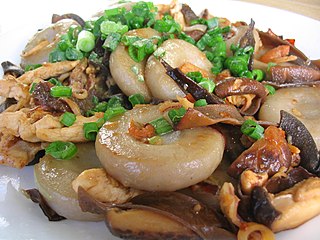Related Research Articles

Hakka cuisine is the cooking style of the Hakka people, and it may also be found in parts of Taiwan and in countries with significant overseas Hakka communities. There are numerous restaurants in Mainland China, Taiwan, Hong Kong, Indonesia, Malaysia, Singapore, India, Thailand, Canada, and the United States serving Hakka cuisine. Hakka cuisine was listed in 2014 on the first Hong Kong Inventory of Intangible Cultural Heritage.

A restaurant is a business that prepares and serves food and drinks to customers. Meals are generally served and eaten on the premises, but many restaurants also offer take-out and food delivery services. Restaurants vary greatly in appearance and offerings, including a wide variety of cuisines and service models ranging from inexpensive fast-food restaurants and cafeterias to mid-priced family restaurants, to high-priced luxury establishments.

A fast-food restaurant, also known as a quick-service restaurant (QSR) within the industry, is a specific type of restaurant that serves fast-food cuisine and has minimal table service. The food served in fast-food restaurants is typically part of a "meat-sweet diet", offered from a limited menu, cooked in bulk in advance and kept hot, finished and packaged to order, and usually available for take away, though seating may be provided. Fast-food restaurants are typically part of a restaurant chain or franchise operation that provides standardized ingredients and/or partially prepared foods and supplies to each restaurant through controlled supply channels. The term "fast food" was recognized in a dictionary by Merriam–Webster in 1951.
McDonaldization is the process of a society adopting the characteristics of a fast-food restaurant. The McWord concept was proposed by sociologist George Ritzer in his 1993 book The McDonaldization of Society. McDonaldization is a reconceptualization of rationalization and scientific management. Where Max Weber used the model of the bureaucracy to represent the direction of this changing society, Ritzer sees the fast-food restaurant as a more representative contemporary paradigm.

Fast food is a type of mass-produced food designed for commercial resale, with a strong priority placed on speed of service. It is a commercial term, limited to food sold in a restaurant or store with frozen, preheated or precooked ingredients and served in packaging for take-out/takeaway. Fast food was created as a commercial strategy to accommodate large numbers of busy commuters, travelers and wage workers. In 2018, the fast food industry was worth an estimated $570 billion globally.

Cha chaan teng, often called a Hong Kong-style cafe or diner in English, is a type of restaurant that originated in Hong Kong. Cha chaan teng are commonly found in Hong Kong, Macau, and parts of Guangdong. Due to the waves of mass migrations from Hong Kong in the 1980s, they are now established in major Chinese communities in Western countries such as Australia, Canada, the United Kingdom, and the United States. Likened to a greasy spoon cafe or an American diner, cha chaan tengs are known for eclectic and affordable menus, which include dishes from Hong Kong cuisine and Hong Kong-style Western cuisine. They draw comparisons to Western cafés due to their casual settings, as well as menus revolving around coffee and tea.
Sweet and sour is a generic term that encompasses many styles of sauce, cuisine, and cooking methods. It is commonly used in East Asia and Southeast Asia and has been used in England since the Middle Ages. Sweet and sour sauce remains popular in Asian and Western cuisines.
Table sharing is the practice of seating multiple separate parties who may not know each other at a single restaurant table.

McDonald's Corporation is an American multinational fast food chain, founded in 1940 as a restaurant operated by Richard and Maurice McDonald, in San Bernardino, California, United States. They rechristened their business as a hamburger stand, and later turned the company into a franchise, with the Golden Arches logo being introduced in 1953 at a location in Phoenix, Arizona. In 1955, Ray Kroc, a businessman, joined the company as a franchise agent and in 1961 bought out the McDonald brothers. Previously headquartered in Oak Brook, Illinois, it moved to nearby Chicago in June 2018. McDonald's is also a real estate company through its ownership of around 70% of restaurant buildings and 45% of the underlying land.

MacDonnell Road is a street in the Mid-Levels area of Hong Kong Island, Hong Kong.
The history of Chinese cuisine is marked by both variety and change. The archaeologist and scholar Kwang-chih Chang says "Chinese people are especially preoccupied with food" and "food is at the center of, or at least it accompanies or symbolizes, many social interactions". Over the course of history, he says, "continuity vastly outweighs change." He explains basic organizing principles which go back to earliest times and give a continuity to the food tradition, principally that a normal meal is made up of grains and other starches and vegetable or meat dishes.

The study of the impact of globalization on women in China examines the role and status of Chinese women relative to the political and cultural changes that have taken place in the 20th century as a consequence of globalization. Globalization refers to the interaction and integration of people, products, cultures and governments between various nations around the globe; this is fostered by trade, investment, and information technology. Globalization affected women's rights and the gender hierarchy in China, in aspects of domestic life such as marriage and primogeniture, as well as in the workplace. These changes altered the quality of life and the availability of opportunities to women at different junctures throughout the modern globalization process.

Evidence suggests that the United States was the first country where two slices of bread and a ground beef patty were combined into a "hamburger sandwich" and sold. There is some controversy over the origin of the hamburger because its two basic ingredients, bread and beef, have been prepared and consumed separately for many years in many countries before their combination. Shortly after its creation, the hamburger quickly included all of its currently typically characteristic trimmings, including onions, lettuce, and sliced pickles.
The Imperial Clan Court or Court of the Imperial Clan was an institution responsible for all matters pertaining to the imperial family under the Ming and Qing dynasties of imperial China. This institution also existed under the Nguyễn dynasty of Vietnam where it managed matters pertaining to the Nguyễn Phúc clan.

A rice burger or riceburger is a variation on the traditional hamburger with compressed rice patties substituted for the hamburger buns. The MOS Burger fast-food restaurant chain introduced the rice burger in Japan 1987, and since then it has become a popular food item in East Asia. Beginning around 2005 McDonald's also offered a rice burger in some of its Asian stores, with mixed results. In South Korea they are known as "bapburgers". Popular Korean-style rice burgers include fillings such as Stir-fried kimchi and tuna with mayonnaise.

Western-style fast food in mainland China is a fairly recent phenomenon, with Kentucky Fried Chicken (KFC) establishing its first Beijing restaurant in November 1987. This location was met with unprecedented success, and served as a model for many local Chinese restaurants that followed it.

Kentucky Fried Chicken is a fast food restaurant chain founded by Colonel Harland Sanders in North Corbin, Kentucky, in 1930. The first franchise opened in Salt Lake City, Utah in 1952.

The Chinese Canadian community in the Greater Toronto Area was first established around 1877, with an initial population of two laundry owners. While the Chinese Canadian population was initially small in size, it dramatically grew beginning in the late 1960s due to changes in immigration law and political issues in Hong Kong. Additional immigration from Southeast Asia in the aftermath of the Vietnam War and related conflicts and a late 20th century wave of Hong Kong immigration led to the further development of Chinese ethnic enclaves in the Greater Toronto Area. The Chinese established many large shopping centres in suburban areas catering to their ethnic group. There are 679,725 Chinese in the Greater Toronto Area as of the 2021 census, second only to New York City for largest Chinese community in North America.
Evelyn Sakakida Rawski is an American scholar of Chinese and Inner Asian history. She is currently a Distinguished University Professor in the Department of History of the University of Pittsburgh. She was born in Honolulu, Hawaii, United States of Japanese-American ancestry. She served as president of the Association for Asian Studies in 1995–1996.
The presence of pizza restaurant chains has contributed to a significant increase in pizza consumption in Mainland China and Hong Kong. This also had an effect of introducing cheese as a culinary ingredient and everyday food in China, which was relatively uncommon in Chinese cuisine prior to the emergence of pizza chains. Pizza Hut opened its first store in China in 1990, and several pizza restaurant chains exist in China today.
References
- Harvard (2015), Dr. James L. Watson, Professor Emeritus , retrieved March 1, 2015
- Watson, James L. "McDonald's in Hong Kong." The Globalization Reader. Ed. Frank J. Lechner and John Boli. 4th ed. Malden, MA: Blackwell, 212. Print.